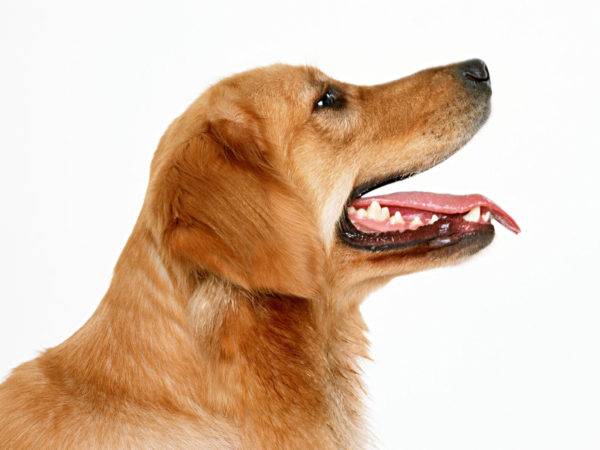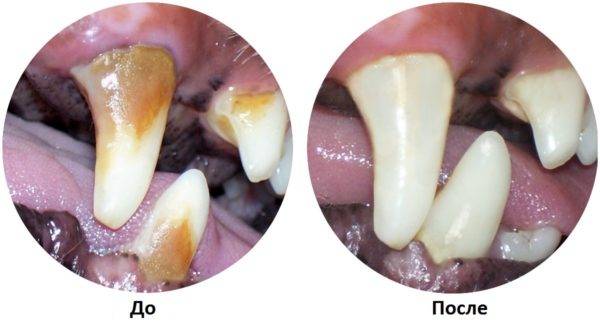Digestive health depends on the condition teeth. This statement is true in relation to domestic to your favorites. Many dental diseases start with process of dental stone formation. As a result, caring the owner must monitor the cleanliness of the dog’s teeth and know how safely and efficiently remove plaque by yourself.
Content
- 1. The composition and structure of stones
- 2. Causes of calculus formation in dogs
- 3. Home treatment
- 4. Therapeutic measures in the clinic
- 5. Preventive measures
Composition and structure of stones
Contents
Tartar in dogs is a deposition of complex composition formed by minerals that make up bone tissue (calcium, phosphorus), iron, food debris served as epithelial cells, bacteria and their metabolic products. Unlike human (pH = 6.5-7.5), the pH of the dog’s saliva is highly alkaline (pH = 9), which reduces the risk of caries, but contributes to increased the formation of dental deposits. 
Tartar differs in consistency and color. In the initial the stage forms a loose coating, consisting of the remnants of food, mucus and bacteria. Plaque or tooth plaque whitish yellow easily removed from enamel. In places where plaque does not accumulate removed naturally by chewing, deposition occurs tartar. Tooth plaques are compacted, impregnated mineral components, and a stone formation is formed. The porous surface of the sediment absorbs dyes, therefore tartar turns yellow, turns brown and then dark, almost black.
The formation of stones on the teeth begins with the smallest mechanical friction – near the edge, near the salivary exit glands. Microorganisms appear on the plaque, which in the process of insoluble minerals compounds that contribute to the hardening of tartar. For, to form a stone, it is enough from 3 months. up to six months. Therefore, veterinarians advise to inspect the teeth once every half a year.
Tartar is formed on the neck of the teeth, can be localized on root or grab part of the tooth crown. Depending on the localization, there are two types of tartar:
- supragingival – is formed above the upper edge of the gums. He’s good visible to the naked eye, easily removed from enamel;
- subgingival is formed below the edge of the gum – between the root and the wall alveoli. It is more “dense” in consistency and much darker in color than supragingival. This type of stone is difficult to remove with ordinary dental tool.
The formation of dense rock-like deposits is affected by many factors. According to statistics, small ones are most prone to stone formation. dog breeds.
You need to know how to brush your dog’s teeth in order to there was no tartar.
Causes of calculus formation in dogs
In a dog, the causes of stone formation are as follows:
- unhealthy diet: the predominance of food that does not have abrasive action on the teeth (soft); sweets and sugar in the diet dogs;
- metabolic disturbance, first of all, water-salt balance;
- gum or tooth disease;
- abnormalities in the development of the dentition or structure of the jaw;
- insufficient hygiene procedures;
- individual features of the structure of the dental crown (microcracks and enamel roughness), etc.
In pets, the process of stone formation does not threaten life, but it the presence of damage to the teeth, affects the state of digestive system, causes gum disease. Also tartar spoils aesthetic perception, causes an unpleasant smell, can cause chronic intoxication of the body.
Bacterial microflora, rapidly developing in the dental sediment, releases toxins that can cause gastritis, ulcer, hepatopathy. Continuous exposure to pathogens microorganisms reduces immunity. Therefore, when if you find tartar in your pet, you must contact your veterinarian or try to remove it yourself deposits.
Home treatment
It is not always possible to get professional help. If dogs have tartar, but there is no way to turn to Vetkliniku, you can try to cope with the problem yourself. Veterinary pharmacies and pet stores have special brushes, toothpastes and powders with which you can remove plaque. IN at pet stores and the Internet you can buy ready-made kits for dogs, eg:
- “8 in 1” D.D.S. Canine Dental Kit;
- Oral Hygiene Kit;
- Hartz Brushn Clean Dental.
In addition to special brushes and pastes, it is recommended to use called “liquid toothbrushes”:
- Dental Fresh;
- Beaphar Fresh Breath Spray;
- Espree Dental Gel with crystals;
- Nutri-Vet “Breath Fresh”.
These oral hygiene products for dogs used when the animal refuses to brush his teeth. For toothbrushing in dogs, you can use a paste made from baby tooth powder and 3% peroxide solution.
To clean the surface of the teeth in pets, you can use special tools for removing stones – Xident Elixir and his analogues. Elixir not only dissolves stones, but also prevents the formation of new deposits. It is recommended to apply once a week Xident on a dog’s teeth with a cotton swab or swab, impregnated with a tool. 
The elixir is not toxic, so it does not need to be washed off. After that, like a tampon or cotton swab held for 2-3 minutes on the teeth, they need wipe with a dry cloth to remove the remaining stone. In Elixir there is anti-inflammatory and disinfectant components.
If the stone cannot be removed chemically, you can try to clean the plaque with a special dental instrument – scaler or metal an object without a cutting edge so as not to injure the gum of the pet. Scaler – a metal hook with a rounded end, fixed on the handle. But any plate that is convenient to clean can come up. stone and you can not injure the gums or damage the enamel.
During mechanical cleaning, the animal’s head must be reliably to fix. Push the lip, put the scaler below the gums to the crown of the tooth. With a confident movement of the scaler, remove the deposits. If a tartar does not lend itself, it should first be softened by the president. It is necessary to carefully remove the stone, not only from the front crown surface, but also between the teeth. After cleansing, gum wipe with a disk moistened with a solution of hydrogen peroxide, for reduce bleeding and disinfection. Gum process Lugol’s solution, which cauterizes small wounds and abrasions.
Not every dog owner can independently carry out the procedure. In the initial stage, when deposits are still loose, you can use for cleaning sticky tablets. In the event that the owner it was not possible to clean the dog’s teeth on their own, you should contact vet clinic. It is not possible to remove stones that formed under the gum of a dog. In this case, only help veterinarian.
Therapeutic measures in the clinic
Rough bedding is best left to a professional. IN in a veterinary clinic, the stone is removed surgically and with using a compact ultrasonic unit. Type of anesthesia depends on the complexity of the procedure and the dog’s patience.
Previously, using a special coloring marker, reveal problem areas, even where with the naked eye dental deposits are not visible. Then tartar is crushed into parts, by action ultrasonic waves polish and protect the teeth with a film of fluorine-containing varnish.
Preventative measures
After removal and sanitation of the oral cavity, measures must be taken prevention of plaque formation:
- observe the feeding regimen;
- Avoid giving your sugar-containing treat
- give cleansing bones after eating;
- food should contain solid pieces that naturally cleanse tooth surface;
- brush your dog’s teeth regularly with a brush and paste;
- apply prophylactic agents, for example, a biological supplement to stern ProDen PlaqueOff.
Continuous dog brushing and preventive measures preserve their health and beautiful appearance of the mouth for a long time pet.






